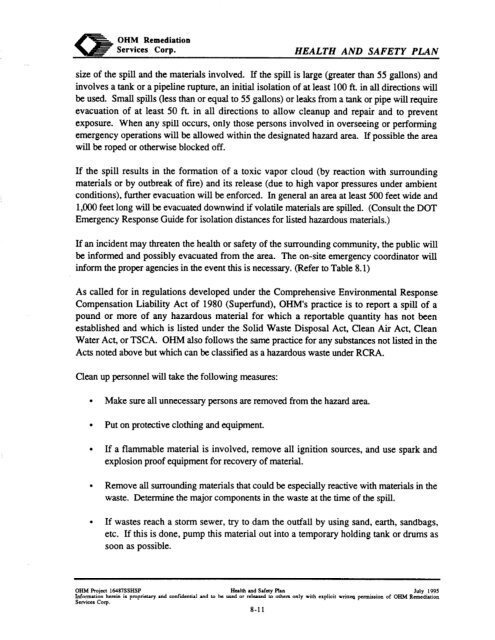work plan for soil remediation, sampling and analysis plan, site ...
work plan for soil remediation, sampling and analysis plan, site ...
work plan for soil remediation, sampling and analysis plan, site ...
You also want an ePaper? Increase the reach of your titles
YUMPU automatically turns print PDFs into web optimized ePapers that Google loves.
OHMRemediationServices Corp. HEALTH AND SAFETY PLANsize of the spill <strong>and</strong> the materials involved. If the spill is large (greater than 55 gallons) <strong>and</strong>involves a tank or a pipeline rupture, an initial isolation of at least 100 ft. in all directions willbe used. Small spills (less than or equal to 55 gallons) or leaks from a tank or pipe will requireevacuation of at least 50 ft. in all directions to allow cleanup <strong>and</strong> repair <strong>and</strong> to preventexposure. When any spill occurs, only those persons involved in overseeing or per<strong>for</strong>mingemergency operations will be allowed within the designated hazard area. If possible the areawill be roped or otherwise blocked off.If the spill results in the <strong>for</strong>mation of a toxic vapor cloud (by reaction with surroundingmaterials or by outbreak of fire) <strong>and</strong> its release (due to high vapor pressures under ambientconditions), further evacuation will be en<strong>for</strong>ced. In general an area at least 500 feet wide <strong>and</strong>1,000 feet long will be evacuated downwind if volatile materials are spilled. (Consult the DOTEmergency Response Guide <strong>for</strong> isolation distances <strong>for</strong> listed hazardous materials.)If an incident may threaten the health or safety of the surrounding community, the public willbe in<strong>for</strong>med <strong>and</strong> possibly evacuated from the area. The on-<strong>site</strong> emergency coordinator wilIin<strong>for</strong>m the proper agencies in the event this is necessary. (Refer to Table 8.1)As called <strong>for</strong> in regulations developed under the Comprehensive Environmental ResponseCompensation Liability Act of 1980 (Super-fund), OHM’s practice is to report a spill of apound or more of any hazardous material <strong>for</strong> which a reportable quantity has not beenestablished <strong>and</strong> which is listed under the Solid Waste Disposal Act, Clean Air Act, CleanWater Act, or TSCA. OHM also follows the same practice <strong>for</strong> any substances not listed in theActs noted above but which can be classified as a hazardous waste under RCRA.Clean up personnel will take the following measures:lMake sure all unnecessary persons are removed from the hazard area.lPut on protective clothing <strong>and</strong> equipment.lIf a flammable material is involved, remove all ignition sources, <strong>and</strong> use spark <strong>and</strong>explosion proof equipment <strong>for</strong> recovery of material.lRemove all surrounding materials that could be especially reactive with materials in thewaste. Determine the major components in the waste at the time of the spill.lIf wastes reach a storm sewer, try to dam the outfall by using s<strong>and</strong>, earth, s<strong>and</strong>bags,etc. If this is done, pump this material out into a temporary holding tank or drums assoon as possible.OHM Project 16487SSHSP Health <strong>and</strong> Safay Plan July 1995Infoormation herein is pmprietary <strong>and</strong> confidential <strong>and</strong> to bc used or released to others only with explicit writtq permission of OHM RemediationServices Corp.8-11
















